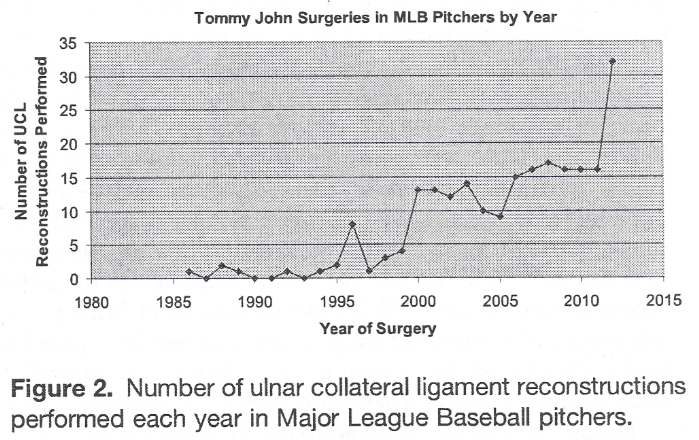 Evidence-based practice vs conventional wisdom of baseball
Evidence-based practice vs conventional wisdom of baseball
In a game that has been American before the existence of the Civil War, its culture is built on decades of history and traditions. This culture also has a big effect on how the game is coached from the youth level all the way to the MLB. The most common prerequisite for finding a qualified coach in baseball is if the coach has any professional experience playing the game. Most of these coaches find themselves sharing the conventional wisdom that helped guide their professional careers.
The problem is baseball is fighting an ever rising injury rate along with an ever rising average fastball. Is continuing to follow the conventional wisdom that has driven this game for centuries the better approach or should we open the doors to a more evidence-based practice?
Evidence-based practice is “the conscientious, explicit and judicious use of current best evidence in making decisions about the care of individual patients, [which] means integrating individual clinical expertise with the best available external clinical evidence from systematic research (Sackett et al., 1996, p. 71).
In this article, I will cover what role evidence-based practice plays in baseball how evidence-based practice influences decision making for coaches decision making and player performance.
What role does evidence-based practice play in baseball?
Evidence-based practice first came into concept out of the medical field. In the medical field it arrived with some controversy as well as here in the baseball world. The debate has actually been around the game for some time. Most popular as the debate of "art" versus "science" of pitching or hitting mechanics, with the conventional wisdom being on the side of coaching the skill as an "art" form.
In the case of proving the benefits of evidence-based practice, it would be most appropriate to look at the evidence. Here is a systematic review by Bazian Ltd (2005) on the ability of evidence-based practice to improve the quality of care in the medical industry.
Of the five randomized controlled trials, two found improvements in the quality of care and three did not. The evidence included in the systematic review was positive, though of lower validity. This is enough to show that evidence-based clinical guidelines are at least capable of improving the care that patients receive.
The irony is evidence-based practice will become more of the standard of care once their is more evidence of its benefits. Based on the review above, the medical industry and specially the baseball industry needs a lot more well constructed case studies to proves its effectiveness.
Collecting this evidence is definitely more urgent of a need in the medical field because of the loss of life issue but there is proof in all industries that standard protocol built on theories can be very wrong. For example, the study below by Sackett and Rosenberg (1995) found that patients receiving treatment of a prescription drug following myocardial infarction actually increased the risk of death.
In selecting a treatment, previously it had been considered sufficient to understand the pathophysiological process in a disorder and to prescribe drugs or other treatments that had been shown to interrupt or otherwise modify this process. Thus, the observation that patients with ventricular ectopic beats following myocardial infarction were at high risk of sudden death, coupled with the demonstration that these extra beats could be suppressed by specific drugs, formed a sufficient rationale for the wide-spread prescription of these drugs to post-infarction patients with unstable cardiac rhythms. However, subsequent randomized controlled trials examined outcomes, not processes, and showed that several of these drugs increase, rather than decrease, the risk of death in such patients, and their routine use is now strongly discouraged.
Once an industry opens it doors to evidence-based practice the challenge then becomes the implementation. Baseball has been known to struggle with this challenge and very often is found "throwing the baby out with the bath water." For example, most young pitchers who try to implement an overhead strengthening routine in-season, as advised by the latest science, find themselves quickly falling into arm fatigue initally. The conventional response of most coaches is to demonize the weight room as doing more harm than good and preventing the young pitcher from lifting in-season again.
The systematic review of evidence-based practice first cited above has found common features of guidelines that are most successfully implement into practice. Here are those features:
- They cover an area of clinical practice which varies greatly and clinicians are aware of this.
- Their evidence base is fairly secure.
- The indication for their use is common in the practice of the targeted clinicians.
- Clinicians are aware of the gaps in their own knowledge about the clinical condition covered by the guideline.
- The benefits of implementation are large:
– for patients, because the change will improve outcomes
– for clinicians, because care will be quicker or easier
– for healthcare systems, because cost savings will follow and outcomes improve
– an authoritative local or national professional body will support the guideline’s use
– there will be time to consult the guidelines (i.e. chronic rather than emergency care).
How can evidence-based practice influence coaches decision making and player performance?
Evidence-based practice for the Coach
The challenge for all coaches to become more evidence-based in their coaching is an open mind. I remember when I first started studying film of pitchers in slow motion and then measuring joint movements through the pitching delivery, many theories I had about how my own delivery worked went straight out the window. If I tried to hold onto how I thought pitching mechanics worked in my mind as opposed to how the science and data was illustrating it for me then I would have never fully made the transition to an evidence-based practice and most important my success as a coach would have been seriously compromised.
It is critical for coaches to take ownership of their knowledge and recognize their limitations if they are going to be able to continue their own education to best inform the young players of this game with the most effective information of the current era. I find this evolution of the baseball coach becoming more urgent everyday as with the ever growing trend of the MLB fastball running parallel to the injury rate, if coaches do not take a more evidence-based approach they may find themselves obsolete very soon in this game.

Graph Source: Erickson BJ, Gupta AK, Harris JD, et al. Rate of Return to Pitching and Performance After Tommy John Surgery in Major League Baseball Pitchers. Am J Sports Med. 2014 42: 536 originally published online December 18, 2013. Accessed May 29, 2014.
The next step for a coach who has committed to an evidence-based practice is to understand if the information doesn't get to the player and benefit his game, it was a waste of effort. The new hurdle becomes either finding the player who is ready to benefit from the knowledge or who can be helped along in their own evolution in this game.
I will never forget, the 2004 Athens Olympic Lifting Coach Gayle Hatch once told me, "If you want to develop an Olympian the formula is simple, find the one who is fully committed to your training." This means the athlete was at a stage of "action" based on the Transtheoretical Model (Prochaska, et al., 1992). This model defines 6 stages of change that individuals go through (Stober, Wildflower & Drake, 2006). There stages are:
- Precontemplation
- Contemplation
- Preparation
- Action
- Maintenance
- Termination
My experience has been when trying to implement evidence-based practice on an athlete who is currently resting in the "precontemplation" stage, that you will spend more time selling your approach to them than implementing it.
Helping to move an athlete along to the "preparation" or "action" stage is first understanding what has tied them down to this stage. Here is a list of variables that make up the context of each players current situation that is critical to understand if you plan to help them evolve from their current situation (Stober, Wildflower & Drake, 2006):
- Age
- Developmental and life stages
- Sociocultural contexts (e.g., gender, culture, socioeconomic status, religious beliefs, etc.)
- Current environmental factors (e.g., career and employment status, networks of communities, levels of stress, etc.)
- Individual and personality factors (e.g., readiness for change, resilience, interpersonal styles, worldviews, self-schemas, etc.)
- Individual expectations for the coaching
Finding the right player at the right time for your evidence-based practice is essential for a coaches success which is why recruiting is the name of the game at the upper levels of most sports especially baseball.
Evidence-Based Practice for The Player
The challenge for the player to benefit from evidence-based practice is either to find a better coach or to become the better coach. If the choice is to become the better coach then the player must follow the advice above. If it is to find the better coach then the player must do their homework and search for the coach that uses an evidence-based practice that they are willing to fully commit too.
Reference:
- Bazian Ltd. Do evidence-based guidelines improve the quality of care? London, UK, 2005
- David L Sackett FRSC MD Msc Epid FRCPC William M C Rosenberg MA MB BS DPhil MRCP. The need for evidence-based medicine. JOURNAL OF THE ROYAL SOCIETY OF MEDICINE. Volume 88 November 1995.
- Dianne R. Stober, Fielding Graduate University, USA Leni Wildflower, Fielding Graduate University, USA David Drake, Catalyst Communications, Inc. Evidence-Based Practice: A Potential Approach for Effective Coaching. USA International Journal of Evidence Based Coaching and Mentoring Vol. 4, No.1, Spring 2006 Page 1



